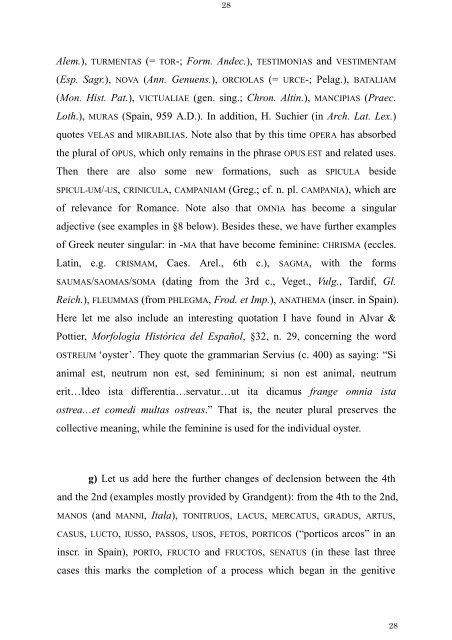The Latin Neuter Plurals in Romance - Page ON
The Latin Neuter Plurals in Romance - Page ON
The Latin Neuter Plurals in Romance - Page ON
You also want an ePaper? Increase the reach of your titles
YUMPU automatically turns print PDFs into web optimized ePapers that Google loves.
28<br />
Alem.), TURMENTAS (= TOR-; Form. Andec.), TESTIM<strong>ON</strong>IAS and VESTIMENTAM<br />
(Esp. Sagr.), NOVA (Ann. Genuens.), ORCIOLAS (= URCE-; Pelag.), BATALIAM<br />
(Mon. Hist. Pat.), VICTUALIAE (gen. s<strong>in</strong>g.; Chron. Alt<strong>in</strong>.), MANCIPIAS (Praec.<br />
Loth.), MURAS (Spa<strong>in</strong>, 959 A.D.). In addition, H. Suchier (<strong>in</strong> Arch. Lat. Lex.)<br />
quotes VELAS and MIRABILIAS. Note also that by this time OPERA has absorbed<br />
the plural of OPUS, which only rema<strong>in</strong>s <strong>in</strong> the phrase OPUS EST and related uses.<br />
<strong>The</strong>n there are also some new formations, such as SPICULA beside<br />
SPICUL-UM/-US, CRINICULA, CAMPANIAM (Greg.; cf. n. pl. CAMPANIA), which are<br />
of relevance for <strong>Romance</strong>. Note also that OMNIA has become a s<strong>in</strong>gular<br />
adjective (see examples <strong>in</strong> §8 below). Besides these, we have further examples<br />
of Greek neuter s<strong>in</strong>gular: <strong>in</strong> -MA that have become fem<strong>in</strong><strong>in</strong>e: CHRISMA (eccles.<br />
<strong>Lat<strong>in</strong></strong>, e.g. CRISMAM, Caes. Arel., 6th c.), SAGMA, with the forms<br />
SAUMAS/SAOMAS/SOMA (dat<strong>in</strong>g from the 3rd c., Veget., Vulg., Tardif, Gl.<br />
Reich.), FLEUMMAS (from PHLEGMA, Frod. et Imp.), ANATHEMA (<strong>in</strong>scr. <strong>in</strong> Spa<strong>in</strong>).<br />
Here let me also <strong>in</strong>clude an <strong>in</strong>terest<strong>in</strong>g quotation I have found <strong>in</strong> Alvar &<br />
Pottier, Morfología Histórica del Español, §32, n. 29, concern<strong>in</strong>g the word<br />
OSTREUM ‘oyster’. <strong>The</strong>y quote the grammarian Servius (c. 400) as say<strong>in</strong>g: “Si<br />
animal est, neutrum non est, sed fem<strong>in</strong><strong>in</strong>um; si non est animal, neutrum<br />
erit…Ideo ista differentia…servatur…ut ita dicamus frange omnia ista<br />
ostrea…et comedi multas ostreas.” That is, the neuter plural preserves the<br />
collective mean<strong>in</strong>g, while the fem<strong>in</strong><strong>in</strong>e is used for the <strong>in</strong>dividual oyster.<br />
g) Let us add here the further changes of declension between the 4th<br />
and the 2nd (examples mostly provided by Grandgent): from the 4th to the 2nd,<br />
MANOS (and MANNI, Itala), T<strong>ON</strong>ITRUOS, LACUS, MERCATUS, GRADUS, ARTUS,<br />
CASUS, LUCTO, IUSSO, PASSOS, USOS, FETOS, PORTICOS (“porticos arcos” <strong>in</strong> an<br />
<strong>in</strong>scr. <strong>in</strong> Spa<strong>in</strong>), PORTO, FRUCTO and FRUCTOS, SENATUS (<strong>in</strong> these last three<br />
cases this marks the completion of a process which began <strong>in</strong> the genitive<br />
28









